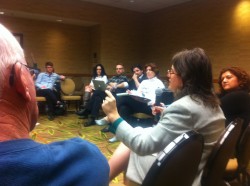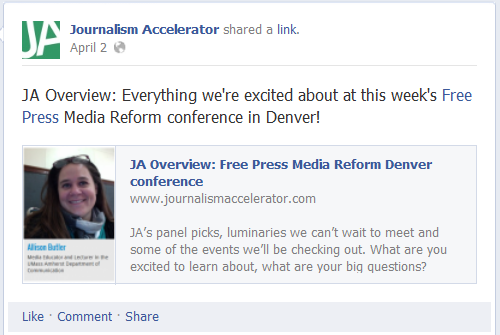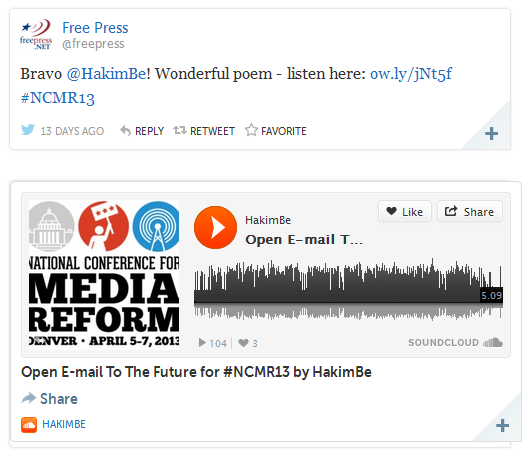Blog:
JA Better Practices: Sixth annual Free Press Media Reform conference inspires a rich social narrative

Hilary Niles weighs in at the "Building Better Media Policy Reporting from the Ground Up" strategy session in Denver, at the Media Reform conference. Credit: Lisa Skube

In early April, JA participated in the Media Reform event, as Josh Stearns, the Journalism and Public Media Campaign Director for Free Press, described it: “A conference of [hundreds] of grassroots media makers.” JA met and talked with dozens of organizers, journalists and policy experts, attended great panels, and had the additional opportunity to meet with a number of leaders such as Jo Ellen Green Kaiser, executive director of Media Consortium; Lark Corbeil and Kimberly Lavender of Public News Service; Dan Moulthrop and Jill Miller Zimon of The Civic Commons; Tom Glaisyer of the Democracy Fund; Journalism That Matters leaders Michelle Ferrier and Peggy Holman; and digital media expert and journalism veteran Steve Outing, in addition to many, many others paired with numerous inspiring hallway conversations.
Covering the event across social channels, the JA designed social coverage to convey the powerful ideas of the people who came to share, learn and compare notes. Building a narrative across social platforms opens up new strategic ways to participate in content, deepen connections and offer important context. Here’s an overview on different ways you might tap into social channels, to develop your own content stream, build a rich narrative, expand your network and bring more return for the investment.
Deepening connection
Looking for fresh ideas on how to transform a conference into lasting value? Have you wondered how the potential of social channels now available can build a deeper narrative around the experience? Or how to build a new audience out of conference participants you’ll be meeting for the first time? And how to bring value to your existing community who may not be on site — the ability to see into what’s unfolding?
Social channels open up an amazingly personalized way of breaking the ice and broadening your sources or professional network, not that there’s always time for most publishers to squeeze it all in. But with some basic pre-planning, and choosing tactics that work for your beat, you can easily come up with a plan. Here’s the social strategy the JA put together in the weeks leading up to the Free Press Media Reform conference –we encourage you to steal things that might work for you!
Preparation: Decide who you want to talk to & why
Conferences are a great opportunity to forge new relationships or strengthen existing ones. Scope out the presenters and identify key people you want to connect with, both new contacts and established connections. If you have access to the attendee list, scan it for those who have complementary or practical experience that is of value to you or your business.
This is where social plays a key role. With most conferences, direct contact information is often not readily available for attendees and panelists. But sometimes these links are hidden on the Web page that features panelists or other conference logistics. If you don’t have an existing connection with who you’d like to reach out to, see if they have a Twitter account.
Follow them, @reply them, or mention them in a tweet saying you intend to attend their presentation and, even better, why. If you are an active LinkedIn user and have shared connections, send them a message. By interacting, you are gaining traction and sharing intention, even if to simply introduce yourself – applying basic reporting skills and turning them into social sweet sauce.
Here’s an example. There were a number of panelists at the Media Reform conference we had noted that have areas of expertise valuable to the JA community, so we reached out to them in advance:
Excited to connect w/ @mstem @chanders @mayalhassen @sutjhally @amandashaffer @iamcrunkadelic at #NCMR13! bit.ly/11dU07R #freepress
— AccelerateJournalism (@journaccel) April 4, 2013
Maytha Hassen (@maythahassen) responded:
Me as well—honored to be featured in this #freepress conference! @journaccel @mstem @chanders @sutjhally @amandashaffer @iamcrunkadelic — Maytha Alhassen (@mayalhassen) April 4, 2013
When I introduced myself to Maya at the conference, she recognized me as from the JA, and we already had a great starting point for our conversation.
Deliberately structure your schedule
Once the group of participants you’ve identified as “must meet” are narrowed down, you can strategically plan the most important events to attend. Prioritize the panels with your identified contacts, and then look for the panels that you think would best inform your own professional development, your audience or your content strategy. How will you share the ideas, tips, information or techniques? What will your readers find most useful? Followers of your Twitter feed? How can you leverage this experience to best inform your community? Select panels that cover topics you know will prove valuable to you and your community.
Create buzz for conference participants AND the outside community
Conferences can help build and expand your audience. Leading up to the day of the conference, connect with other attendees by tapping into event hashtags and tagging the conference event page or the conference’s sponsor organizations in your Facebook posts.
The return on this is threefold: 1) It puts you on the radar of conference participants who haven’t heard of you before, 2) it shows other participants you’re attending so they can connect with you at the conference, and 3) it informs your community of what you intend to cover during the conference.
During: Tweet with integrity
When tweeting about the event, keep in mind that you are not just tweeting to the community at the conference, but to your entire community of followers. Make tweets universally informative and valuable. Share information in a way that someone not present would understand. Whenever you can, use Twitter handles of organizations cited and/or links to specific articles or information mentioned. For example, one panel we attended was on the subject of media literacy, and a panelist referenced a blog that several of the panelists contributed to. I quickly researched the name of the blog so I could share it with the community, and it was one of the most retweeted and favorited tweets from the entire event, both from conference participants and JA followers at large:
What if public schools had media lit ed & colleges had media activism majors?#NCMR13 #Medialiteracy panel blog medialiteracyatncmr.wordpress.com — AccelerateJournalism (@journaccel) April 6, 2013
People love direct quotes from the panels
It gives them a sense of direct participation. With quotes especially, it is important to include context. For instance, this quote was from a speaker in the Digital Activism panel, which focused on energizing online communities.
We’re building a large movement, but we are also empowering individuals. @jodielayne of @ihollaback ihollaback.org #digifem #NCMR13 — AccelerateJournalism (@journaccel) April 5, 2013
Note that I included the direct inspirational quote, the speaker of the quote, her organization, a link to her organization to put her work in context, and the hashtags of both the panel and the overall conference.
Take lots of pictures
Images are especially engaging. Give your community a direct glimpse into the conference. When you take pictures of panels, make notes of the people in the panels and which panel the picture is from. This tip applies to pictures of individuals as well — note the people and their organization — it will prove invaluable for follow-up work.
Storify in real time
If you want to go deep, like we do here at the JA, use Storify to document the event as you go along. Storify allows you to capture tweets and build permanent documentation of the live conversation. While in a panel, follow panel-specific tweets with the hashtag from the event and save them to your Storify in real time. This will save you the hassle of having to sift through hundreds of tweets from the event afterward. Then, in retrospect, you can go back and organize as need be. For examples of this, see our Storifies from the Media Reform conference.
After: Share the love
Create a Facebook album (or Flickr or Instagram album, etc).
People love images. Having a visual representation of your experience brings it home. And the notes you took earlier “in real time” are put into play — tagging people and organizations will let your contacts know they are appreciated and recognized, strengthening relationships as well as expanding your ability to deepen research and collaboration. You also can easily share the album on other platforms such as Twitter or LinkedIn, or you can embed it in your website or blog.
Refine your Storify
Now that you have a rough draft from which to build your Storify, you can transform this into a full package for those who want to reflect on the conference and for those who could not attend. A big advantage of Storify is that it doesn’t limit your story to just tweets; it is source agnostic and plays well with the full-spectrum of online media. When reviewing the tweets you saved, pull in websites, videos, articles or even audio files referenced. All of this creates a rich, layered, interactive experience for the viewer. A neat way of breaking down a complex story and offering it in a fresh way.
A great example of this is the audio file embedded in our Storify: Writer Hakim Bellamy read a poem during the opening ceremony and you can listen to it directly from our Storify thread!
Acknowledge your connections. Follow up with all the great people you meet at the conference, new and old. Send tweets with specific memories you found inspiring, and, whenever possible, link to the work of your colleagues. It will be appreciated and grow good will and connection, which socially is part of what makes up that elusive “secret sauce.”
Mulch it
Till back into the soil things that most inspire you. As an example, we had collected some of the tweets we thought best captured the spirit of the event. Share back, even a week or two later, some of what you’ve seen cross the Twitter stream to share with others. From this year’s sixth annual Media Reform conference, here’s a handful of JA’s top tweet picks:
“Part of advocacy is creating a narrative that people can understand.” – @astradisastra #NCMR13 — Mandy Van Deven (@mandyvandeven) April 6, 2013
I’m no longer a FT freelancer but damn we need to talk more about solidarity networks for reporters w/out institutional support. #NCMR13 — Susie Cagle (@susie_c) April 6, 2013
@jodielayne personal narratives are important in helping people realize the necessity of change #digifem #NCMR13 — Emily Stoner (@emilysuggests) April 5, 2013
Collaboration, collective, coalition. Do work that’s rooted in love. – @iamcrunkadelic #digifem #NCMR13 #positivevibes — Kate Siegfried (@ksiegfried) April 5, 2013
Big takeaway from @josephatorres at #NCMR13: We are a networked movement making change together at the intersection of media and justice. — Josh Stearns (@jcstearns) April 5, 2013
What inspired you most from this year’s Media Reform conference, or what do you wish it had covered? How do you use social to deepen connections? Share your better practices or ways you tap into social to get the most out of it.











Weigh In: Remember to refresh often to see latest comments!
1 comment so far.
Checking tweets on a session while I am attending that session–Twitinteractivity–helps broaden the context beyond my normal sphere.